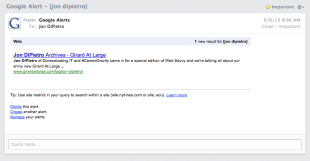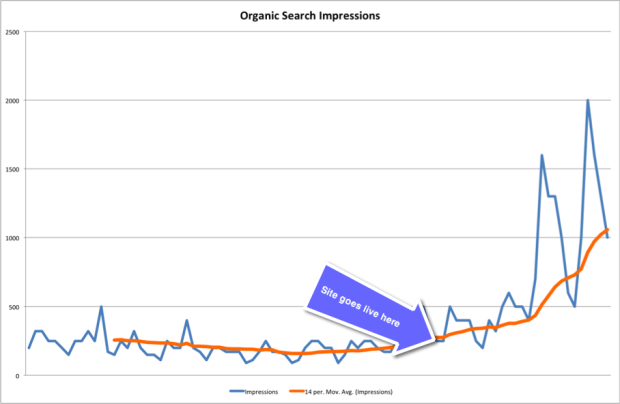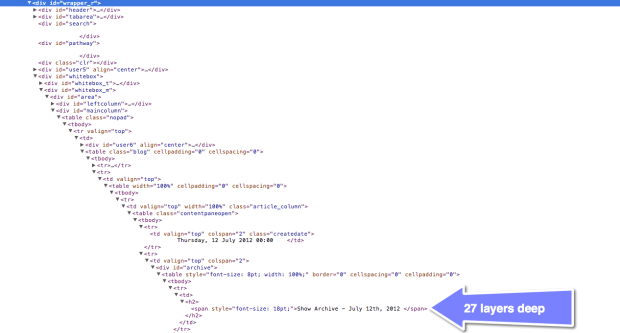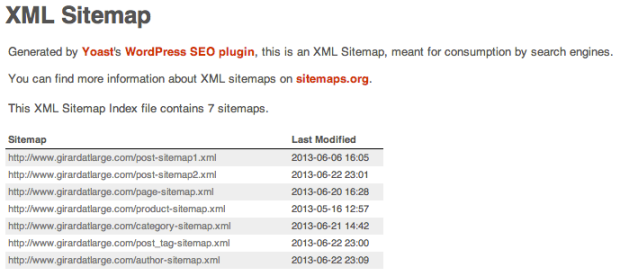The new Girard at Large website is approaching 30 days since its launch. But it didn’t take nearly that long to realize that something was very, very different from its previous incarnation. Almost instantly, there were already messages from Google that essentially said, “I see what you did there.” There were indirect signs like Google Alert notifications and direct signs like organic search data.
Four days after the site went live, the first archive of my Web Savvy segment was posted. I received a Google Alert within minutes of that post being published. I had never received one in the previous three months of web savvy posts.

Another sign appeared when I noticed that a Google search for “Domesticating IT” included the archives from the new Girard at Large website. But that’s just anecdotal evidence, so how about some data? I’m glad you asked because it’s even more impressive. Here is a graph from Google Webmaster showing the number of daily search impressions for www.girardatlarge.com:
The blue line shows the number of daily search impressions and the orange line is a 14 day moving average. The anecdotal evidence and the data are making a clear point: A new website infrastructure can have a huge impact on search engine visibility. So let’s take a look at what’s changed in this SEO case study.
Clean Up Your Act
[nonmember]The Inbound Marketing Inquirer is a weekly premium article that’s free to view for members. Create a free account now:
[register_inquirers (free)][/nonmember]
[ismember]
Google is a machine. More specifically, it’s a computer algorithm. When we talk about “spiders” that “crawl” the Internet, we’re talking about computer programs that look at web pages and analyze them. What the crawlers see and what you see, however, are two very different things. The search engines are looking at the HTML code that define the page’s content. If this code is complex, messy and unstructured then the crawler is going to have a very hard time understand what’s important and what isn’t.
One major difference with the new Girard at Large website is the simplicity of the HTML that is generated by WordPress and the theme that’s being used. It’s important to note here that WordPress in and of itself is not necessarily a superior SEO choice. The theme you use is also important. Here is a before and after comparison of the HTML code for one of the show archive posts. You don’t need to know what you’re looking at to understand that one is much, much more complex than the other.
This first code listing illustrates that you need to 27 layers deep into the page’s HTML code before you reach the post title. It’s not only 27 layers deep, it’s embedded inside a table that’s inside a table that’s inside a table. When content is buried underneath this many layers, it’s a signal to the search engines that it isn’t all that important.
Compare that to an archive post on the new WordPress website. The post title is just 6 layers deep and not embedded inside of any tables. The search engine’s job is much easier and the signal-to-noise ratio is extremely low compared to the old site. Cleaning up the HTML on your site can make a big difference.
Add Structure
Search engines rely on certain signals in order to identify important words on your website. When they appear in titles, heading tags, menu navigation and links, they consider those words to have higher importance. But WordPress has another feature that provides very strong and clear signals to search engines about important keywords; categories and tags. When you apply categories and tags to your posts, WordPress also automatically creates archive pages that contain a list of posts for each of them.
The Google Alert I received is a perfect example of the power of tagging. I wasn’t alerted to one specific page or post on the website. Google saw a new archive with posts that were attributed to me and alerted me about it.
Help Google Help You
There’s one other tool that was added to this new website; XML sitemaps. These are XML files that act as a table of contents for search engines. And they don’t just provide a list of articles. They categorize the pages and make it easier for the crawlers to differentiate and organize those listings. There are maps for pages, posts, tags, categories, authors, products, etc. The easier you can make it for the crawlers, the better your results are going to be!
[/ismember]
Top Marketing Stories of the Week
Homepage Sliders: Bad For SEO, Bad For Usability
If you read this article be sure to read the comments below the article! There seems to be quite a backlash against the author but it was certainly thought-provoking for me. It’s always good to challenge your assumptions and think about alternatives.
Finnegan’s Irish Pub And Grill In Stockton, Calif., Uses Facebook As A Velvet Rope
This pub wanted to reduce the alarming increase in Friday night fighting and instituted “Facebook Friday,” which only admits Facebook friends of the pub. It’s been so successful that they expanded it to Saturday.
How to Leverage Investment in Video to Build More Links
This is a comprehensive and incredibly useful article that includes a long list of tips and suggestions for leveraging video as part of your inbound marketing strategy.





Trackbacks/Pingbacks